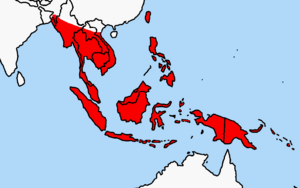Polynesian Rat facts for kids
Quick facts for kids Polynesian Rat |
|
|---|---|
 |
|
| Scientific classification | |
| Kingdom: | |
| Phylum: | |
| Class: | |
| Order: | |
| Family: | |
| Subfamily: | |
| Genus: | |
| Species: |
R. exulans
|
| Binomial name | |
| Rattus exulans (Peale, 1848)
|
|
 |
|
| Polynesian Rat range in South-east Asia (in red) | |
The Polynesian rat, also known as the Pacific rat (Rattus exulans), is a small rodent. The Māori call it kiore. It is the third most common rat species in the world. Only the brown rat and black rat are found in more places.
This rat first came from Southeast Asia. But like its relatives, it has traveled far and wide. It has spread to many islands in Polynesia. These islands include New Zealand, Fiji, and Hawaii.
Contents
About the Polynesian Rat
The Polynesian rat is smaller than other common rats. It usually weighs between 40 and 80 grams. Its body is slender, and its fur is reddish-brown. It has large ears and a long, thin tail. The tail is often as long as its body or even longer.
What Makes Them Special?
One interesting fact about this rat is its feet. Its hind feet are quite long. This helps it climb trees and plants easily. Polynesian rats are very good climbers. They often build their nests in trees or thick bushes.
Where Do They Live?
Polynesian rats live in many different places. They can be found in forests, grasslands, and even near human homes. They prefer warm, tropical climates. This is why they thrive on Pacific islands.
They are mostly active at night, which means they are nocturnal. During the day, they rest in their nests. Their nests are often made from plant materials like leaves and grass.
Diet and Habits
Polynesian rats are omnivores. This means they eat both plants and animals. They are not picky eaters and can find food in many environments.
What Do They Eat?
Their diet includes seeds, fruits, and insects. They also eat small lizards, bird eggs, and even young birds. On islands, they sometimes eat the eggs of ground-nesting birds. This can be a problem for native bird populations.
How They Find Food
These rats are very good at finding food. They use their strong sense of smell to locate ripe fruits and hidden insects. They also store food in their nests for later. This helps them survive when food is scarce.
Reproduction and Life Cycle
Polynesian rats can reproduce quickly. This helps them spread to new areas. A female rat can have several litters of pups each year.
How They Have Babies
A litter usually has between 3 and 6 pups. The pups are born blind and without fur. They rely completely on their mother for care. They grow very fast. Within a few weeks, they are ready to explore on their own.
Their Lifespan
In the wild, Polynesian rats usually live for about one year. However, if they have enough food and a safe place, they can live a bit longer. Their short lifespan means they need to reproduce often to keep their population strong.
Impact on Islands
When Polynesian rats arrived on new islands, they often caused big changes. This is because islands have unique plants and animals. These species are often not used to predators like rats.
How They Arrived
These rats traveled with early human explorers. They likely hitched rides on canoes and boats. This allowed them to reach many remote islands across the Pacific Ocean. They were often brought along by accident.
Challenges for Nature
On islands, Polynesian rats sometimes eat the seeds of native plants. They also prey on the eggs and chicks of native birds. This can harm the island's natural balance. It can even lead to some species becoming endangered or extinct.
Conservationists work to protect native species from these rats. They use different methods to control rat populations. This helps to keep the island ecosystems healthy.
See also
 In Spanish: Rata de la Polinesia para niños
In Spanish: Rata de la Polinesia para niños

